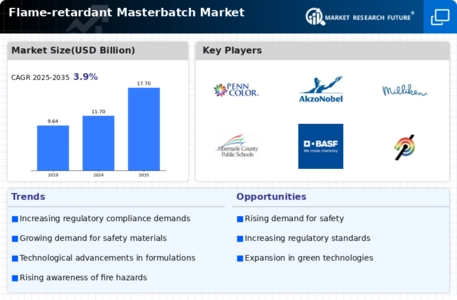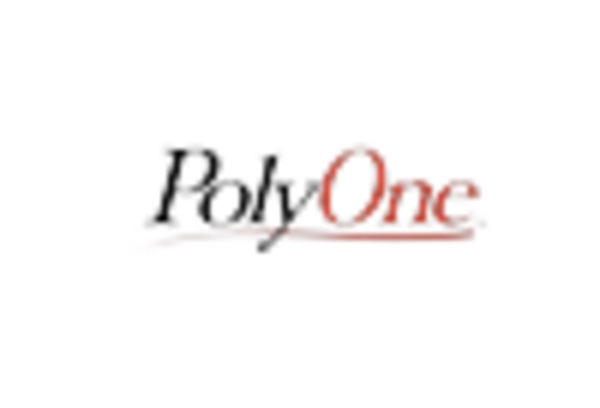Rising Awareness of Fire Safety
The Flame-retardant Masterbatch Market is witnessing a heightened awareness of fire safety among consumers and industries alike. This growing consciousness is prompting manufacturers to invest in flame-retardant solutions that meet or exceed safety standards. In 2025, it is anticipated that the market will see a substantial increase in demand for flame-retardant masterbatches across various sectors, including automotive, textiles, and electronics. The automotive industry, in particular, is expected to drive significant growth, as vehicle manufacturers seek to enhance passenger safety through the incorporation of flame-retardant materials. This trend suggests that the flame-retardant masterbatch market will continue to evolve, with a focus on developing products that not only comply with safety regulations but also offer improved performance characteristics.
Emerging Markets and Economic Growth
The Flame-retardant Masterbatch Market is poised for growth in emerging markets, where economic development is driving increased construction and manufacturing activities. Countries in Asia and Latin America are witnessing rapid industrialization, leading to a surge in demand for flame-retardant materials. In 2025, it is expected that these regions will contribute significantly to the overall market growth, as local industries adopt flame-retardant masterbatches to comply with safety regulations and enhance product performance. This trend suggests that manufacturers may focus on establishing production facilities in these emerging markets to capitalize on the growing demand. As a result, the flame-retardant masterbatch market is likely to expand, driven by the economic growth and evolving safety standards in these regions.
Increasing Demand from Construction Sector
The Flame-retardant Masterbatch Market experiences a notable surge in demand from the construction sector, driven by stringent fire safety regulations. As urbanization accelerates, the need for fire-resistant materials in buildings becomes paramount. In 2025, the construction industry is projected to account for a significant share of the flame-retardant masterbatch market, with estimates suggesting a growth rate of approximately 6% annually. This trend indicates that manufacturers are increasingly focusing on developing innovative flame-retardant solutions tailored for construction applications, thereby enhancing safety and compliance with regulatory standards. Furthermore, the integration of flame-retardant masterbatches in insulation materials and structural components is likely to bolster market growth, as stakeholders prioritize fire safety in their projects.
Growth in Electronics and Electrical Applications
The Flame-retardant Masterbatch Market is experiencing robust growth due to the increasing use of flame-retardant materials in electronics and electrical applications. As the electronics sector expands, the demand for materials that can withstand high temperatures and prevent fire hazards is becoming critical. In 2025, it is projected that the electronics industry will significantly contribute to the flame-retardant masterbatch market, with a focus on applications such as cables, connectors, and housings. The integration of flame-retardant masterbatches in these products not only enhances safety but also ensures compliance with international safety standards. This trend indicates a promising future for the flame-retardant masterbatch market, as manufacturers strive to meet the evolving needs of the electronics sector.
Technological Innovations in Masterbatch Production
Technological advancements play a crucial role in shaping the Flame-retardant Masterbatch Market. Innovations in production techniques and formulation chemistry are enabling manufacturers to create more effective and efficient flame-retardant masterbatches. In 2025, the market is likely to benefit from the introduction of new additives and processing technologies that enhance the performance of flame-retardant materials. For instance, the development of nanotechnology-based flame retardants is expected to revolutionize the industry by providing superior fire resistance while minimizing environmental impact. This evolution in technology not only meets the increasing demand for high-performance materials but also aligns with the sustainability goals of various industries, thereby driving growth in the flame-retardant masterbatch market.

















Leave a Comment